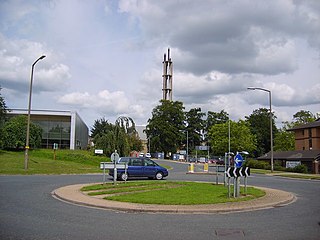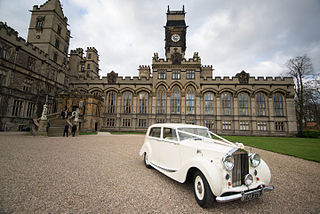
Heslington is a suburban village and civil parish within the City of York district, in the ceremonial county of North Yorkshire, England, south-east of the centre of York. Before 1974, it was a village in the Derwent Rural District, which was part of the East Riding of Yorkshire. From 1974 to 1996 it was part of the Selby district before becoming part of the new City of York unitary authority area.

The University of York is a collegiate research university in York, England. Established in 1963, the university has expanded to more than thirty departments and centres, covering a wide range of subjects.
Earl of Swinton is a title in the Peerage of the United Kingdom. It was created in 1955 for the prominent Conservative politician Philip Cunliffe-Lister, 1st Viscount Swinton. He had already been created Viscount Swinton, of Masham in the County of York, in 1935, and was made Baron Masham, of Ellington in the County of York, at the same time he was given the earldom. Born Philip Lloyd-Greame, he was the husband of Mary Constance "Molly" Boynton, granddaughter of Samuel Cunliffe-Lister, 1st Baron Masham. When his wife inherited the large Masham estates in 1924, they assumed the surname of Cunliffe-Lister in lieu of Lloyd-Greame.
Baron Deramore, of Belvoir in the County of Down, is a title in the Peerage of the United Kingdom. It was created on 18 November 1885 for the Conservative Member of Parliament Sir Thomas Bateson, 2nd Baronet. His father Thomas Bateson had been created a baronet, of Belvoir Park in the County of Down, on 18 December 1818 in the Baronetage of the United Kingdom. The barony was created with special remainder to the first Baron's younger brother George, who succeeded him as second Baron.

Easton Neston is a large grade I listed country house in the parish of Easton Neston near Towcester in Northamptonshire, England. It was built by William Fermor, 1st Baron Leominster (1648–1711), in the Baroque style to the design of the architect Nicholas Hawksmoor.
This is a list of people who have served as Lord Lieutenant for the East Riding of Yorkshire. The office was established after the English Restoration in 1660, when a Lord Lieutenant was appointed for each Riding of Yorkshire. Since 1721, all Lord Lieutenants have also been Custos Rotulorum of the East Riding of Yorkshire, and for part of the period also Lieutenants of the Town and County of the Town of Kingston upon Hull. It was abolished on 31 March 1974 with the creation of the county of Humberside, but was re-created upon the abolition of Humberside on 1 April 1996.

Sewerby Hall is a Grade I listed Georgian country house set in 50 acres (20 ha) of landscaped gardens in the village of Sewerby, 2 miles (3.2 km) from the seaside town of Bridlington in the East Riding of Yorkshire, England.

Carlton Towers in the civil parish of Carlton, 5 miles (8 km) south-east of Selby, North Yorkshire, England, is a very large Grade I listed country house, in the Gothic Revival style, and is surrounded by a 250-acre park.
Philip Charles Hardwick was an English architect.

Richard Arthur de Yarburgh-Bateson, 6th Baron Deramore was a British architect, writer of erotic fiction, and a peer of the United Kingdom.

Charles Edward Stourton, 23rd Baron Stourton, 27th Baron Segrave, 26th Baron Mowbray was an English peer. He sat on the Conservative benches in the House of Lords and was a Conservative whip in government and in opposition from 1967 to 1980. He was one of the 92 hereditary peers elected to keep their seat in the reformed House of Lords under the House of Lords Act 1999.
There have been two baronetcies created for persons with the surname Bateson, one in the Baronetage of Ireland and one in the Baronetage of the United Kingdom.
The Borthwick Institute for Archives is the specialist archive service of the University of York, York, England. It is one of the biggest archive repositories outside London. The Borthwick was founded in 1953 as The Borthwick Institute of Historical Research. It was originally based at St Anthony's Hall, a fifteenth-century guild hall on Peasholme Green, in central York. Since 2005 it has been based in a purpose-built building, situated adjacent to the JB Morrell Library on the University of York's Heslington West campus. This new building was made possible due to a grant of £4.4 million by the Heritage Lottery Fund and designed by Leach Rhodes Walker and Buro Happold.
Arthur Duncombe, was a British Conservative politician.

Charles the Twelfth (1836–1859) was a British Thoroughbred racehorse and sire best known for winning the classic St Leger Stakes in 1839. He ran a dead-heat with Euclid in the classic before winning the prize in a deciding heat.

St Lawrence Parish Church is an active Anglican church in York, England. It is situated in Lawrence Street, just outside Walmgate Bar.
Lieutenant-Colonel Robert Wilfrid de Yarburgh-Bateson, 3rd Baron Deramore was a British peer and an officer in the Yorkshire Hussars. He served as Lord Lieutenant of the East Riding of Yorkshire from 1924 until his death in 1936.

More House is the Catholic chaplaincy for the University of York in Heslington, York. The building itself dates from the late 18th century. The chaplains were formerly Carmelite friars resident in the building, but since 2021 priests from York Oratory have been ministering to the chaplaincy. It is located on Main Street in Heslington, which is towards the south edge of the university's Campus West. It is a Grade II listed building.

The Charles XII, commonly referred to as The Charles, is a pub in Heslington, York.















